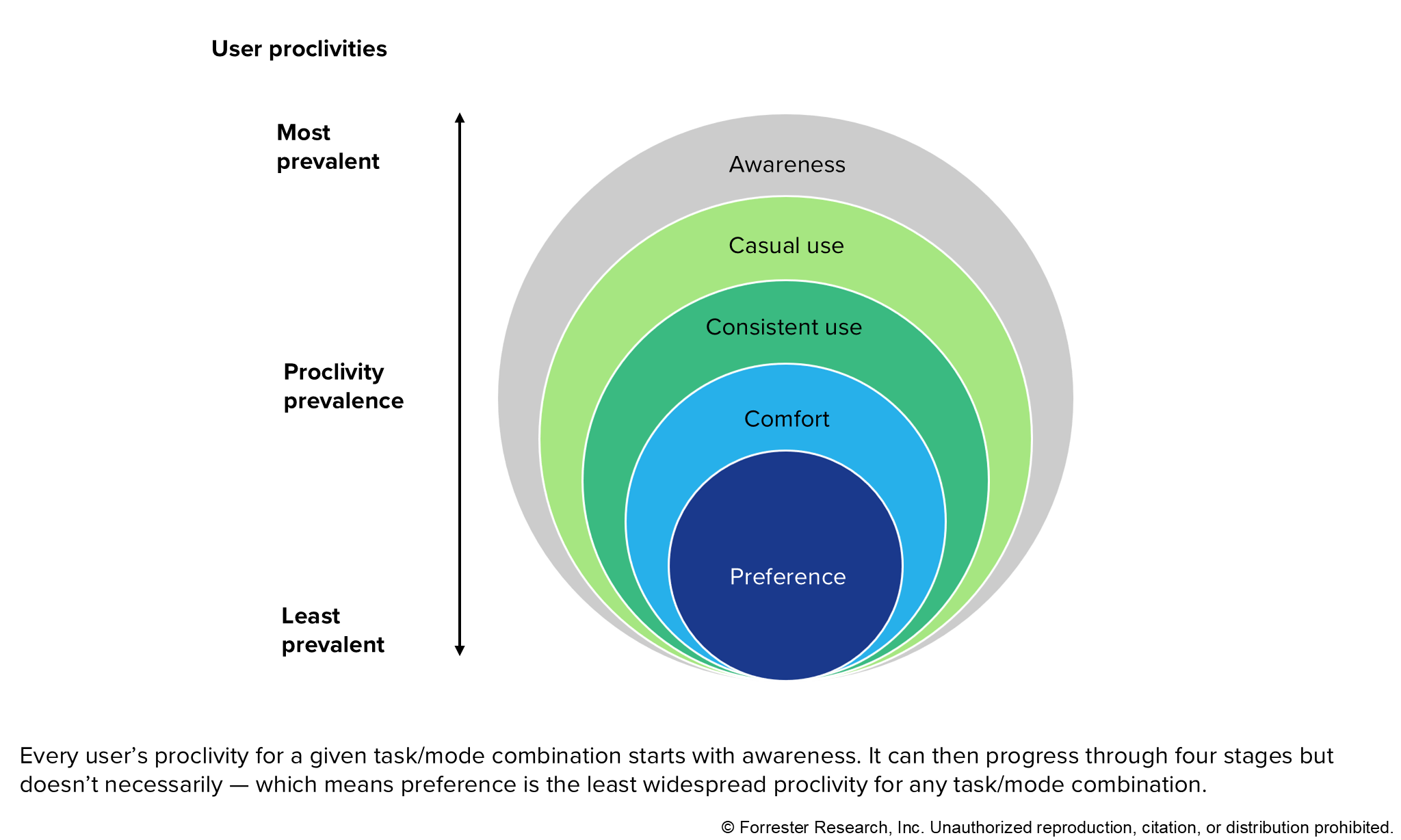Design Digital Experiences That Reflect Where And How Europeans Engage Today And In The Future
GUI, Chat, Voice, XR, Oh My!
With the proliferation of social media platforms, smart devices, and conversational interfaces, the ways Europeans interact with brands have expanded. Customer touchpoints now span websites, mobile apps, chatbots, email, voice assistants, and even wearable tech — each presenting a unique opportunity to acquire, engage, and serve.
Customers – more empowered, discerning, and willing to explore than ever – expect convenient, seamless, and value-driven experiences from brands. Meanwhile, CX and digital business leaders often voice frustrations such as “We launched this new feature, but hardly anyone is using it — and we don’t understand why” or “We implemented a chatbot, but engagement is low. How do we get customers to actually use it?” These challenges typically arise from a mismatch between the solution and customer’s actual needs. Sometimes, the tool fails to address the problem effectively — or worse, it’s solving the wrong problem entirely. Moreover, customer behavior is deeply influenced by context. People interact with digital tools differently depending on their environment, goals, and constraints in the moment.
Digital Behaviors Continue To Evolve
Customers are increasingly using voice commands through virtual assistants on smartphones or smart speakers to control devices and access information – valuing speed and hands-free convenience. Yet for tasks such as checking on a delayed delivery, those same users may prefer texting with a support agent via a chat interface. For more involved activities, such as consumption and commerce tasks, they often turn to a rich graphical user interface (GUI) on a smartphone — for example, to compare product reviews before making a purchase or transaction. These shifting preferences underscore how context — from environment to urgency — shapes digital behavior.

Understand The European Digital Consumer Landscape
To meet rising customer expectations and design digital experiences that truly resonate, organizations must ground their digital strategies in a deep, data-driven understanding of their users. This starts with uncovering actionable insights into audience behaviors and preferences. To steer your digital experience (DX) strategy effectively, you need to understand which interaction modes (e.g., GUI, voice, chat, etc.) consumers use for various tasks (e.g., control, communication, commerce, etc.) and how many devices, channels, and platforms they rely on. That’s why we developed two powerful tools: the Digital Moments Map and the Digital Connections Tracker. Each combines a dataset and a model to help you make smarter DX decisions.
The Digital Moments Map
The Digital Moments Map assesses user behaviors and attitudes across 16 different combinations of interaction modes and task types based on an annual Forrester survey. It helps answer questions such as “What percentage of people in Germany prefer using voice for control tasks, such as adjusting a smart thermostat?” We’ve just published five European market-specific reports in this series to support these decisions:
- The Digital Moments Map, 2024: France
- The Digital Moments Map, 2024: Germany
- The Digital Moments Map, 2024: Italy
- The Digital Moments Map, 2024: Spain
- The Digital Moments Map, 2024: UK
This task-based approach highlights the importance of designing experiences that are both context-aware — responsive to the user’s situation — and preference-driven, tailored to individual needs and expectations.
The Digital Connections Tracker
The Digital Connections Tracker assesses how many devices, channels, and platforms people rely on – by region/market — based on an annual Forrester survey. It helps answer questions such as “How many devices, channels, and platforms are people using on average this year in France?” These insights, for instance, can help you determine whether your marketing campaigns are reaching users across the right number of touchpoints. Here are the five European market-specific reports in this series:
- The Digital Connections Tracker, 2024: France
- The Digital Connections Tracker, 2024: Germany
- The Digital Connections Tracker, 2024: Italy
- The Digital Connections Tracker, 2024: Spain
- The Digital Connections Tracker, 2024: UK
These reports reveal that European consumers are highly connected, engaging across an expanding array of devices, channels, and platforms — often simultaneously. A typical consumer might browse a product on a tablet, compare prices on a smartphone, and finalize the purchase on a desktop. This multidevice, multichannel, multiplatform behavior has redefined customer expectations; consistency and continuity across digital touchpoints are now a requirement. To meet these expectations, brands must deliver seamless, integrated digital experiences, regardless of where, when, or how users choose to connect.
Develop A Data-Driven DX Strategy
Together, these reports highlight a critical shift: DX strategies must evolve beyond product- and channel-centric approaches to become context-aware — understanding the nuances of digital moments — and channel- and device-agnostic. A deep understanding of where, how, and why people interact across digital channels enables organizations to:
- Adopt a customer-first mindset. Start with the end user and work backwards to inform strategy and execution.
- Prioritize with purpose. Use data-driven insights to focus on what truly matters, while confidently deciding what not to pursue.
- Design unified digital experiences. Create seamless, context-aware interactions that are connected, convenient, and aligned with user needs.
By quantifying digital engagement patterns, organizations can confidently choose and justify their DX investments, enhance UX, boost engagement, and anticipate future needs.
Let’s Connect
Forrester provides clients with custom guidance and data. To get started, schedule a guidance session with me to discuss the models and data in more detail. You can also request custom data cuts segmented by country, year, age group, income band, and more — depending on your specific needs.
